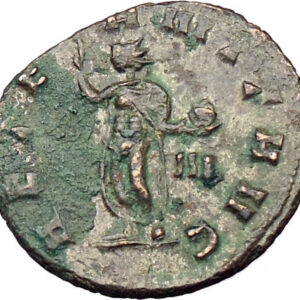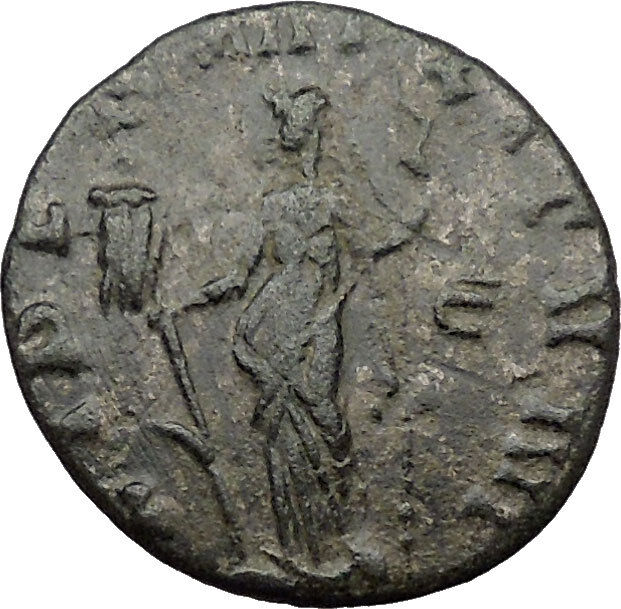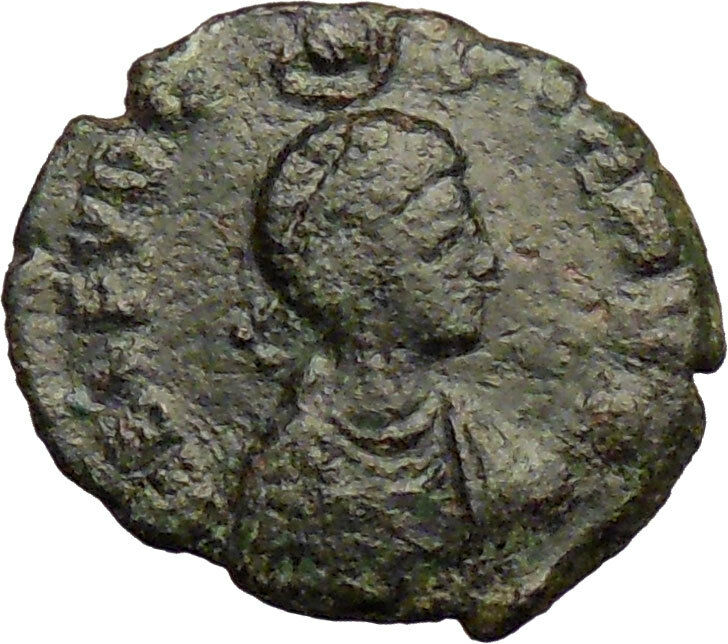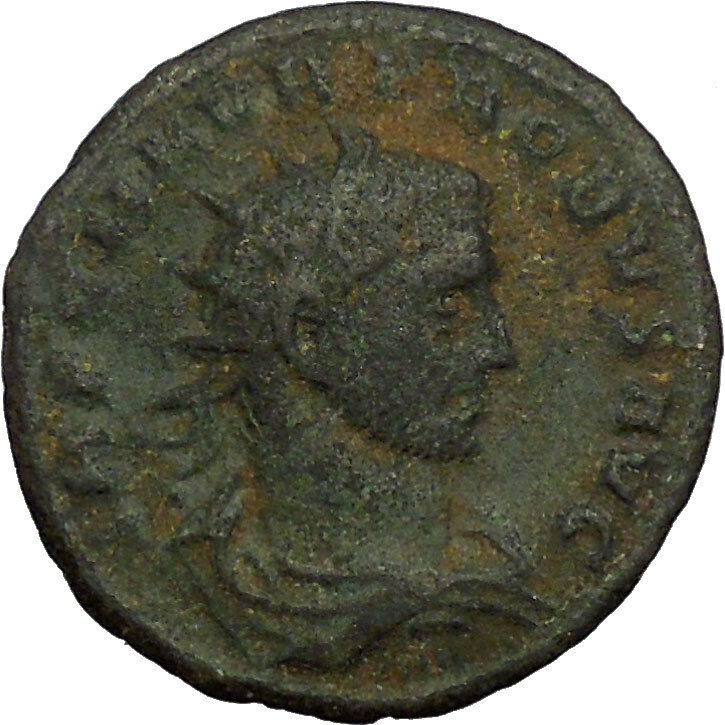Bronze AE3 19mm (2.55 grams) Sirmium mint 364-367 A.D.
Reference: Sirmium RIC 6a
DN VALENTINIANVS P F AVG, diademed, draped & cuirassed bust right
RESTITVTOR REIP, Valentinian standing facing holding labarum and Victory, HSIRM
in ex.
Authenticity.
From Eusebius, two accounts of a battle survive. The first, shorter one in
the
Ecclesiastical History
leaves no doubt that
God helped Constantine but doesn’t mention any vision. In his later Life of
Constantine, Eusebius gives a detailed account of a vision and stresses that
he had heard the story from the emperor himself. According to this version,
Constantine with his army was marching somewhere (Eusebius doesn’t specify the
actual location of the event, but it clearly isn’t in the camp at Rome) when he
looked up to the sun and saw a cross of light above it, and with it the Greek
words
Ἐν Τούτῳ Νίκα
. The traditionally employed
Latin translation of the Greek is
in hoc signo vinces
— literally “In this
sign, you will conquer.” However, a direct translation from the original Greek
text of Eusebius into English gives the phrase “By this, conquer!”
The vision has been interpreted in a solar context (e.g. as a
solar halo
phenomenon), which would have been
reshaped to fit with the Christian beliefs of the later Constantine.
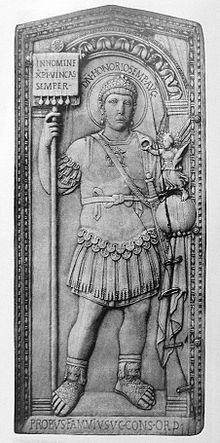
The emperor
Honorius
Among a number of standards depicted on the
Arch of Constantine
res publica
INSTINCTV DIVINITATIS
MENTIS MAGNITVDINE (“by greatness of mind and by instinct [or impulse]
of divinity”). As with his predecessors, sun symbolism – interpreted as
representing
Sol Invictus
(the Unconquered Sun) or
Helios
,
Apollo
or
Mithras
– is inscribed on his coinage, but in
325 and thereafter the coinage ceases to be explicitly pagan, and Sol Invictus
disappears. In his
Historia Ecclesiae
Eusebius further reports
that, after his victorious entry into Rome, Constantine had a statue of himself
erected, “holding the sign of the Savior [the cross] in his right hand.” There
are no other reports to confirm such a monument..
Whether Constantine was the first
Christian
emperor supporting a peaceful
transition to Christianity during his rule, or an undecided pagan believer until
middle age, strongly influenced in his political-religious decisions by his
Christian mother
St. Helena
, is still in dispute among
historians.
As for the labarum itself, there is little evidence for its use before 317.In
the course of Constantine’s second war against Licinius in 324, the latter
developed a superstitious dread of Constantine’s standard. During the attack of
Constantine’s troops at the
Battle of Adrianople
the guard of the labarum
standard were directed to move it to any part of the field where his soldiers
seemed to be faltering. The appearance of this talismanic object appeared to
embolden Constantine’s troops and dismay those of Licinius.At the final battle
of the war, the
Battle of Chrysopolis
, Licinius, though
prominently displaying the images of Rome’s pagan pantheon on his own battle
line, forbade his troops from actively attacking the labarum, or even looking at
it directly.[16]
Constantine felt that both Licinius and
Arius
were agents of Satan, and associated them
with the serpent described in the
Book of Revelation
(12:9).
Constantine represented Licinius as a snake on his coins.
Eusebius stated that in addition to the singular labarum of Constantine,
other similar standards (labara) were issued to the Roman army. This is
confirmed by the two labara depicted being held by a soldier on a coin of
Vetranio
(illustrated) dating from 350.
The Chi Rho is one of the earliest
christograms
used by Christians. It is formed by superimposing the
first two letters in the Greek spelling of the word
Christ
(
Greek
: “Χριστός” ), chi = ch and rho = r, in such a way to produce
the monogram
☧. The Chi-Rho symbol was also used by pagan Greek scribes to
mark, in the margin, a particularly valuable or relevant passage; the
combined
letters Chi and Rho standing for chrēston, meaning “good.”
Although not technically a cross, the Chi Rho invokes the crucifixion
of Jesus as well as symbolizing his status as the Christ. There is early
evidence of the Chi Rho symbol on Christian Rings of the third century.
The labarum (Greek:
λάβαρον) was a
vexillum
(military standard) that displayed the “Chi-Rho”
symbol, formed from the first two
Greek letters
of the word “Christ”
(Greek:
ΧΡΙΣΤΟΣ, or Χριστός) — Chi (χ)
and Rho (ρ).
It was first used by the
Roman emperor
Constantine I
. Since the vexillum consisted of a flag suspended from
the crossbar of a cross, it was ideally suited to symbolize
crucifixion
. The Chi-Rho symbol was also used by Greek scribes to
mark, in the margin, a particularly valuable or relevant passage; the
combined letters Chi and Rho standing for chrēston, meaning
“good.”
Flavius Valentinianus, known in English as
Valentinian I, (321
–
November
17
, 375
)
was Roman Emperor
from 364 until his death. Valentinian is often referred to as
the “last great western emperor”.[1]
Both he and his brother Emperor
Valens
were
born at
Cibalae
(modern days
Vinkovci
,
Croatia
), in
Pannonia
,
the sons of a successful general,
Gratian the Elder
.
//
Life
He had been an officer who served under the emperors
Julian
and Jovian
, and had risen high in the imperial service. Of robust frame and
distinguished appearance, he possessed great courage and military capacity.
After the death of Jovian, he was chosen emperor in his forty-third year by the
officers of the army at
Nicaea
in Bithynia
on
February
26
, 364, and shortly afterwards named his brother
Valens
colleague with him in the empire.
The two brothers, after passing through the chief cities of
the neighbouring district, arranged the partition of the empire at
Naissus
(Nissa) in Upper
Moesia
. As
Western Roman Emperor, Valentinian took
Italia
,
Illyricum
, Hispania
, the Gauls
,
Britain
and
Africa
, leaving to
Eastern Roman Emperor
Valens the eastern half of the
Balkan peninsula
,
Greece
,
Aegyptus
,
Syria
and
Asia Minor
as far as
Persia
. They were immediately confronted by the revolt of
Procopius
, a relative of the deceased Julian. Valens defeated his army at
Thyatira
in Lydia
in 366, and Procopius was executed shortly afterwards.
During the short reign of Valentinian there were wars in
Africa, in Germany
, and in Britain, and
Rome came into
collision with
barbarian
peoples, specifically the
Burgundians
and the
Saxons
.
Valentinian’s chief work was guarding the frontiers and
establishing military positions.
Milan
was at
first his headquarters for settling the affairs of northern Italy. The following
year (365) Valentinian was at
Paris
, and then
at
Reims
, to direct the operations of his generals against the
Alamanni
.
These people, defeated at Scarpona (Charpeigne) and Catelauni (Châlons-en-Champagne)
by Jovinus, were driven back to the German bank of the
Rhine
, and
checked for a while by a chain of military posts and fortresses. At the close of
367, however, they suddenly crossed the Rhine, attacked Moguntiacum (Mainz)
and plundered the city. Valentinian attacked them at Solicinium (Sulz
am Neckar, in the
Neckar
valley
, or
Schwetzingen
) with a large army, and defeated them with great slaughter. But
his own losses were so considerable that Valentinian abandoned the idea of
following up his success.
Later, in 371, Valentinian made peace with their king,
Macrian
, who
from that time remained a true friend of the
Romans
.
The next three years he spent at
Trier
, which he
chiefly made his headquarters, organizing the defence of the Rhine frontier, and
personally superintending the construction of numerous forts.
During his reign the coasts of Gaul were harassed by the
Saxon pirates, with whom the
Picts
and
Scots
of northern Britain joined hands, and ravaged the island from the
Antonine Wall
to the shores of
Kent. In 368
Count Theodosius
was sent to drive back the invaders; in this he was
completely successful, and established a new British province, called
Valentia
in honour of the emperor.
In Africa,
Firmus
raised the standard of revolt, being joined by the provincials, who
had been rendered desperate by the cruelty and extortions of
Comes
Romanus,
the military governor. The services of Theodosius were again requisitioned. He
landed in Africa with a small band of veterans, and Firmus, to avoid being taken
prisoner, committed suicide.
In 374, the
Quadi
, a
Germanic tribe
in what is now
Moravia
and
Slovakia
,
resenting the erection of Roman forts to the north of the
Danube
in what
they considered to be their own territory, and further exasperated by the
treacherous murder of their king,
Gabinius
,
crossed the river and laid waste the province of Pannonia. The emperor in April,
375 entered Illyricum with a powerful army. But during an audience to an embassy
from the Quadi at
Brigetio
on the Danube (near today Komárno in Slovakia), Valentinian
suffered a burst
blood
vessel
in the skull while angrily yelling at the people gathered. This
injury resulted in his death on November 17, 375.
Reputation
A.H.M. Jones
writes that though he was “less of a boor” than his chief rival
for election to the imperial throne, “he was of a violent and brutal temper, and
not only uncultivated himself, but hostile to cultivated persons”, as
Ammianus
tells us, ‘he hated the well-dressed and educated and wealthy and
well-born’. He was, however, an able soldier and a conscientious administrator,
and took an interest in the welfare of the humbler classes, from which his
father had risen. Unfortunately his good intentions were often frustrated by a
bad choice of ministers, and an obstinate belief in their merits despite all
evidence to the contrary.”[2]
According to the
Encyclopædia Britannica 1911
, he was a founder of schools, and provided
medical attendance for the poor of
Rome, by appointing
a physician for each of the fourteen districts of the city.
Valentinian was a
Christian
but permitted liberal religious freedom to all his subjects, proscribing only
some forms of rituals such as particular types of sacrifices, and banning the
practice of magic. Against all abuses, both civil and ecclesiastical (excepting,
of course, his own excesses), Valentinian steadily set his face, even against
the increasing wealth and worldliness of the clergy. His chief flaw was his
temper, which at times was frightful, and showed itself in its full fierceness
in the punishment of persons accused of witchcraft, some kinds of
fortune-telling or magical practices.”










